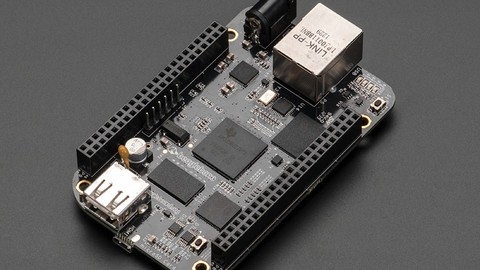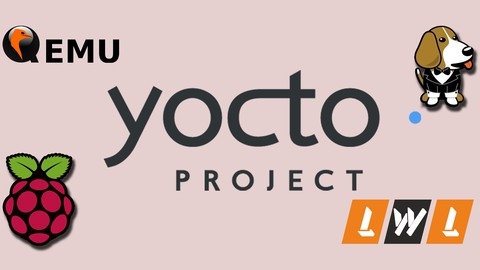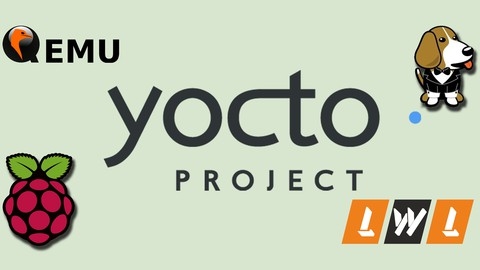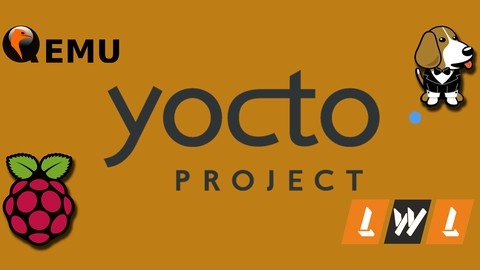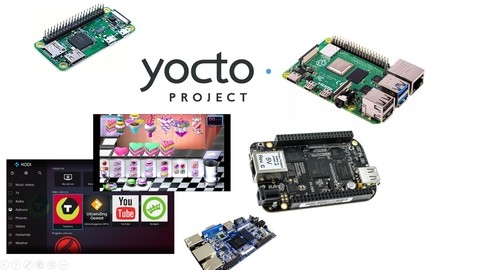Embedded Linux is the backbone of countless embedded systems, powering everything from smart home devices to industrial automation systems.
By mastering Embedded Linux, you can unlock a world of possibilities, enabling you to create innovative and efficient solutions for a wide range of applications.
Learning Embedded Linux opens doors to exciting career opportunities in the rapidly growing field of embedded systems development, allowing you to contribute to cutting-edge technologies and shape the future of connected devices.
Finding the right Embedded Linux course on Udemy that aligns with your learning style and goals can be challenging, given the abundance of options available.
You’re looking for a course that goes beyond theory, providing practical hands-on experience and real-world projects to solidify your understanding.
You want a course that not only covers the fundamentals but also delves into advanced topics, equipping you with the skills and knowledge necessary to excel in this dynamic field.
We’ve meticulously reviewed numerous Udemy courses and, based on our comprehensive analysis, Embedded Linux Step by Step Using Beaglebone Black emerges as the best overall course for mastering Embedded Linux.
This course offers a structured and comprehensive approach, guiding you through the intricacies of Embedded Linux development using the popular Beaglebone Black platform.
It covers a wide range of topics, from setting up your development environment to building custom applications, providing a solid foundation for your Embedded Linux journey.
While Embedded Linux Step by Step Using Beaglebone Black is our top recommendation, there are other excellent courses available on Udemy that cater to specific learning styles and preferences.
Keep reading to explore our curated list of recommendations, covering various aspects of Embedded Linux development, including Yocto Project, kernel development, and advanced system programming.
Find the perfect Embedded Linux course on Udemy to empower your learning journey and propel you towards your career goals.
Embedded Linux Step by Step Using Beaglebone Black
You’ll start by diving into the intricacies of the BBB’s hardware, exploring the powerful AM335x System on a Chip (SoC) and its diverse peripherals, including the SD card, DDR3 memory, and Ethernet PHY.
You’ll learn how to connect the BBB to your computer using a USB-to-UART converter, then master tools like Minicom, Teraterm, and Putty to communicate with it.
The course then delves into the fascinating process of embedded Linux booting, unraveling the boot sequence step by step.
You’ll gain a deep understanding of the roles played by the ROM, SPL (Second Stage Boot Loader), U-boot, and the Linux Kernel.
You’ll get hands-on experience building and flashing images, mastering various booting methods like serial port, TFTP, and eMMC.
You’ll utilize the Linux Device Tree to customize the kernel for the specific hardware of your BBB, and learn about initramfs and uEnv.txt to personalize your system’s initial configuration.
Buildroot, a powerful tool for constructing a complete embedded Linux system from scratch, will be at your fingertips.
You’ll become proficient in using essential tools like Eclipse, a popular IDE, and Busybox, a minimalist root filesystem that provides essential utilities.
You’ll master the art of writing C applications to interact with the BBB’s hardware, controlling user LEDs and interfacing with external devices such as a 7-segment LED display and an MPU6050 sensor.
Finally, the course culminates in interfacing with a 16x2 LCD, teaching you how to write code to display text and graphics.
Embedded Linux using Yocto
If you’re looking to dive into the world of embedded Linux development, the “Embedded Linux using Yocto” course is a solid foundation for your journey.
This syllabus lays out a comprehensive path to understanding the Yocto Project, a powerful tool for building custom embedded systems.
You’ll start with the basics, defining what embedded Linux is and then quickly move into the intricacies of the Yocto Project.
This course doesn’t just teach you theory; it equips you with practical skills.
You’ll set up your own build machine and learn to work with the Poky distribution, a critical tool in Yocto development.
You’ll gain a firm grasp of key concepts like metadata, oe-core, and bitbake, all essential for creating your own embedded systems.
You’ll even build a “Hello World” project, testing your newfound knowledge by running it on a QEMU emulator.
The real meat of this course lies in building custom images using Yocto.
You’ll learn to navigate different layers and tools, customizing your build process to create tailored images for platforms like BeagleBone Black and Raspberry Pi 3.
You’ll learn the ins and outs of the boot process on these boards and master the art of flashing your creations onto them.
Beyond building images, you’ll delve into the Yocto Project’s various release cycles and gain a deep understanding of BSP layers like meta-ti and meta-raspberrypi.
You’ll explore advanced topics like adding extra space to the root file system, setting up SSH support, and utilizing the “wic” utility for flashing images.
You’ll have a strong foundation in the tools, layers, and processes involved, empowering you to develop and deploy innovative embedded systems for a wide range of applications.
Embedded Linux Using Yocto Part 2
You’ll start by mastering the fundamentals of variables and operators in Yocto.
These tools allow you to manipulate and manage data within your project, which is essential for efficient development.
You’ll learn how to assign values to variables, use different types of operators, and even override default styles.
Next, you’ll dive into the concept of layers, which are like modular building blocks for your Yocto project.
You’ll understand why they’re so important for maintaining a well-structured and reusable system.
You’ll learn how to create, configure, and even check the compatibility of your layers, ensuring a smooth development process.
You’ll then move on to image creation, where you’ll learn how to assemble the final product of your Yocto project.
You’ll gain the ability to build custom images from scratch, add software packages, and even reuse existing images to create new variations.
This hands-on experience gives you the flexibility to build precisely the Linux system you need.
The course also covers image features, which are like customization options for your image.
You’ll explore features like debug tweaks, read-only root file systems, and splash screens.
This gives you the power to tailor your image to specific requirements, ensuring a system that’s perfect for your project.
You’ll then delve into recipes, the blueprints for building software components for your embedded system.
You’ll learn how to write your own recipes, build them using the bitbake tool, and even integrate them into your image’s root file system.
This is where you’ll gain the skills to develop software specifically for your embedded environment.
The course also emphasizes the importance of logging in Yocto.
You’ll learn how to enable debug output, explore log and run files, and even use Python logging functions for efficient troubleshooting.
This provides you with the tools to identify and resolve problems effectively.
Finally, you’ll master Git recipes, which are essential for managing software using the Git version control system.
You’ll learn how to add compile and install tasks to recipes, select specific revisions, fetch from local or private repositories, and even patch source code.
This gives you complete control over your software development process, ensuring consistency and traceability.
Embedded Linux using Yocto Part 4
You’ll start with the fundamentals, understanding how Yocto’s incremental build system accelerates development and how the Shared State Cache plays a vital role in optimizing build performance.
You’ll learn the ins and outs of setscene, a powerful tool for managing your build environment and ensuring consistency across different builds.
You’ll then delve into the concept of Stamps, which are used to track changes in the build process.
Understanding Stamps is essential for effectively leveraging bitbake-dumpsig and bitbake-diffsigs to analyze and manage these changes.
You’ll also discover SSTATE_DIR, where cached build data is stored, and how to keep it clean using bitbake clean tasks.
The course goes beyond the basics, equipping you with the knowledge to craft your own Yocto Linux Kernel Recipes.
You’ll learn about the WORKDIR, where you’ll customize your kernel using configuration fragments and defconfig files.
You’ll also gain a deep understanding of the differences between Yocto’s kernel repository and a traditional kernel repository.
The curriculum dives into the world of package groups, teaching you how to create and utilize these collections of related packages.
You’ll master the nuances of RRECOMMENDS and RDEPENDS, key dependencies for packages.
You’ll explore RPROVIDES and virtual targets, powerful mechanisms for building flexible and highly adaptable systems.
The course concludes by introducing you to the concept of offline builds, enabling you to create systems without an internet connection.
This powerful feature is essential for development in environments with limited network access.
You’ll also learn how to handle out-of-tree modules, which are modules not found in the main kernel tree.
You’ll discover how to build, include, and automatically load these modules at system startup.
Yocto Zero to Hero - Building embedded Linux
You’ll gain a solid understanding of how Yocto works and its significance in embedded Linux development.
Right from the start, you’ll be creating your first Yocto image and setting it up to run on a Raspberry Pi, getting hands-on with the technology.
The course then delves into the intricacies of extending Yocto images, introducing you to “.bbappend” files, which allow you to fine-tune your Yocto environment.
You’ll learn how to build your own custom distributions, effectively tailoring Yocto to your specific needs.
You’ll also be diving deep into the realm of application and kernel development, learning how to write C code and create your own kernel modules, adding unique functionalities to your system.
A significant focus is placed on package management, illustrating how to build a popular media player, Kodi, on your Raspberry Pi.
This practical application allows you to see how the knowledge you’ve acquired can be used to create real-world projects.
With a precompiled Kodi image included, you can immediately start exploring its features and see your efforts come to fruition.
Embedded Linux Full Course ( 2 embedded linux application)
This Embedded Linux course offers a comprehensive exploration of file input/output operations, laying a strong foundation for building powerful embedded applications.
You’ll start by understanding the fundamentals of file I/O, learning how to read, write, and manage files within your Linux environment.
You’ll then delve into advanced techniques like navigating files using lseek and utilizing file permissions to control access.
You’ll learn to leverage standard C library functions like feof, ferror, and fstat for error handling and file information retrieval.
You’ll also master the use of fopen and fclose for efficient file operations, gaining proficiency in navigating the Linux file system structure, including directories and links.
The second half of the course shifts focus to process management, equipping you with essential knowledge about system signals, process IDs, and the powerful fork function.
You’ll discover how to create new processes, effectively manage child processes, and understand the nuances of zombie and orphan processes.
Finally, the course culminates with an exploration of the exec function, empowering you to replace the current process with a new application.
By completing this course, you’ll acquire a robust understanding of embedded Linux fundamentals, enabling you to write sophisticated and efficient applications for a wide range of embedded systems.
